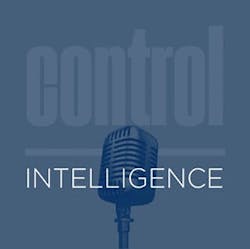In this episode of Control Intelligence, editor-in-chief Mike Bacidore explains the history of RS-232 and its role in industrial manufacturing.
Transcript
Recommended Standard 232 (RS-232) was introduced as EIA-232 in the 1960s by the Electronic Industries Association, which disbanded into multiple sectors in 2011 and remain cohesive as the Electronic Industries Alliance. Version C of the recommended standard has remained the most current since 1969.
RS-232 standardized serial communication between computers and peripherals. Data is transmitted one bit at a time over a single wire or pair of wires, which is different from parallel communication, in which multiple bits can be transmitted simultaneously over distinct wires in both directions—transmit (TX) and receive (RX).
The universal asynchronous receiver/transmitter (UART) is an integrated circuit essential for serial communication. One example of UART technology is in an artificial intelligence of things (AIoT) application.
UARTs take parallel data from a computer's memory and convert it into serial data. The electrical characteristics of UART communication was defined by RS-232. This helped to ensure compatibility across manufacturers’ devices. Before RS-232’s adoption, proprietary communication interfaces with their unique specifications and limitations were common.
RS-232 defines voltage levels for binary data. Positive voltage from 12 V to 15 V is represented as a 0, and negative voltage from -12 V to -15 V is represented as a 1. The two non-return-to-zero states protect it from electrical noise because of the bipolar signaling’s robustness.
Connectors with a fixed number of pins, such as DB-9 and DB-25, are most common. RS-232 serial interface cables should be shielded, low-capacitance cables, grounded at both ends.
RS-232 also defines several control signals, such as request to send (RTS) and clear to send (CTS). These signals enable handshaking and flow control.
Because RS-232 operates asynchronously, there’s no shared clock signal. Devices are able to synchronize communication using each character’s start bit, stop bit and data bits. The transmitting and receiving devices must agree on a baud rate—bits/second (bps)—to time data transmission. It is designed for short-distance communication up to 50 ft. Data errors can occur over longer distances due to signal degradation. For longer distances, RS-485, which is derived from RS-232, is often used.
RS-485’s primary difference from RS-232 is its use of differential signaling, making it even more immune to electrical interference and extending its communication distance. RS-485 data transmission capabilities can reach 4,000 ft (1,200 m) or greater, depending on cable quality and baud rate.
Another distinguishing factor about RS-485 is its multi-point communication. It can support up to 32 devices on a single bus, connected in numerous topologies, which is why it’s so attractive for industrial automation and networking applications.
RS-232 remains popular and effective in many industrial, scientific and telecommunications applications because of its reliability and relative immunity to electrical interference, but it has been replaced by USB, Ethernet and wireless technologies for personal and commercial use such as connecting peripheral devices to computers.
RS-232 is used for configuring and troubleshooting routers, switches and other network equipment by using a console connection.
RS-232 still provides a reliable means of communication between programmable logic controllers (PLCs), sensors and human-machine interfaces (HMIs). Many legacy devices rely on RS-232, and converters/adapters are often used to bridge the gap between RS-232 and other communication standards to integrate those legacy components into systems.
RS-232 connections are used for interfaces to monitor and troubleshoot devices during the development and testing phases in the development of hardware and software. Many development boards and microcontroller modules feature RS-232 interfaces for programming and debugging purposes.
Despite its advantages, RS-232 is not without its limitations. With a maximum data rate around 115.2 kbps, its high-speed data transfer capabilities are no match for USB or Ethernet. It also uses higher voltage levels, which requires level shifters or converters when interfacing RS-232.
RS-232 was instrumental in connecting mainframes and computers to external devices, such as printers, dumb terminals for remote data entry, modems, data acquisition (DAQ) systems and scientific instruments. This connectivity led to the development of local area networks (LANs), which follow the IEEE 802 standards that include Ethernet and other means of connecting multiple devices. Ethernet allows for data transmission over longer distances and at higher speeds than RS-232.
Ethernet uses packet-switching technology—data is sent over the network in packets. It supports simultaneous communication between multiple devices, which enables faster data transmission. Ethernet also operates in a full-duplex mode, which means data can be sent and received simultaneously.
USB has become the standard for most personal and commercial peripheral connections. Besides faster data-transfer rates, USB devices are hot-swappable, as opposed to RS-232, which typically require reconfiguring and rebooting the computer. Power is another benefit of USB, which eliminates the need for separate power cables. And, while RS-232 can provide communication between computers and serial devices, USB supports a wider range of devices. USB connectors and cables are typically smaller and easier to manage than their RS-232 equivalents.
About the Author
Mike Bacidore
Editor in Chief
Mike Bacidore is chief editor of Control Design and has been an integral part of the Endeavor Business Media editorial team since 2007. Previously, he was editorial director at Hughes Communications and a portfolio manager of the human resources and labor law areas at Wolters Kluwer. Bacidore holds a BA from the University of Illinois and an MBA from Lake Forest Graduate School of Management. He is an award-winning columnist, earning multiple regional and national awards from the American Society of Business Publication Editors. He may be reached at [email protected]

Leaders relevant to this article:

